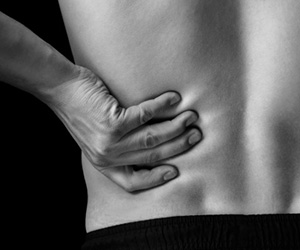Patient Education: Lumbar Spinal Stenosis / Radiculopathy (Pinched Nerve)

By the age of 50, 95% of people will see degenerative changes to the spine. Degeneration in the spine can lead to narrowing of the spinal canal, a condition called spinal stenosis. Lumbar spinal stenosis, or stenosis occurring in the lower back, is a common cause of lower back and leg pain. Lumbar stenosis is most common in those over the age of 60. Lumbar radiculopathy or a “pinched nerve” can occur in any age group and is most commonly caused by a herniated disc.
Causes and Symptoms
Stenosis is most commonly caused by degeneration over time through arthritis. When we are young, the discs in our spine have a high water content. As we age, the discs begin to dry out, causing them to weaken, settle, and collapse. This puts pressure on the facet joints of the spine, often resulting in arthritis. This also narrows the spaces that the nerves pass through. If the cartilage wears away, the bones may begin to rub together, which can result in bone spurs. Arthritis can also cause the ligaments surrounding the joints to swell, narrowing the spinal canal.
When the space around the spinal cord, called the spinal canal, narrows, it puts pressure on the spinal cord and the spinal cord roots. This can cause pain, numbness, or weakness in the legs. Depending on the severity of the arthritis, patients with lumbar stenosis may have back pain. Some patients experience a burning pain that usually starts in the buttocks and radiates down the leg. This is called sciatica. This can progress to a numb or tingling sensation as pressure on the spinal nerves increases, and can eventually result in weakness in one or both legs. Some patients may also develop a “foot-drop,” a feeling of the foot slapping on the ground when walking.
Some may find relief from symptoms when sitting or leaning forward, which can sometimes increase the space for the nerves. Pain is generally worse when standing or walking.
Treatment Options for Lumbar Stenosis / Radiculopathy
There are several treatment options for lumbar stenosis, including both surgical and nonsurgical methods. Dr. Rajadhyaksha will always try to use the least invasive methods possible to relieve your symptoms.
Nonsurgical Treatment
While nonsurgical treatment methods cannot improve the narrowing of the spinal canal, they can provide relief of the associated symptoms.
Nonsurgical treatment can include physical therapy, with stretching exercises and massage to help increase the strength of the lumbar and abdomen. Patients may also use non-steroidal anti-inflammatory drugs (NSAIDS) to help manage pain. Epidural steroid injections or pain blocks may be administered a few times a year to help decrease pain and swelling. Chiropractic manipulation of the spine can also be helpful in some cases, but should be avoided if a patient has osteoporosis or disc herniation.
Surgical Treatment
If nonsurgical treatment methods fail to provide relief, and the condition is interfering with the patient’s quality of life, surgery may be considered.
For a pinched nerve or herniated disc, the piece of disc that is pushing on the nerve can be shaved away to relieve the pressure on the nerve. This is usually done under a microscope to provide excellent visualization.
There are two surgical options that are most commonly used to treat lumbar stenosis: laminectomy and spinal fusion. Dr. Rajadhyaksha will discuss surgical options with you before proceeding.
A laminectomy, also called a “decompression,” involves removing any components, like bones, bone spurs, and ligaments, that are putting pressure on the nerves. This can be done either as an open surgery, with a single, larger incision, or as a minimally invasive procedure, with smaller incisions. During a minimally invasive laminectomy, the surgeon relies on a microscopes to see inside the spinal canal. X-rays may also be taken during the surgery to get a better view of the anatomy.
Spinal fusion involves permanently joining together two or more vertebrae. Bone graft is used and can be placed over a portion of the spine or in between vertebrae. Rods, screws, plates, or cages may also be used to help immobilize the vertebrae until the bone grafts have fully healed. Often, a combination of spinal fusion and laminectomy is used.
Following surgery, rehabilitation is necessary to help build up strength, flexibility, and stability in the spine. These exercises can also help to strengthen the abdomen to help support the back. You may also wear a brace or corset to help support your back following surgery, and are usually encouraged to begin walking as soon as possible. Most patients will return to their normal activities within two to three months of surgery.
Lumbar Spinal Stenosis Treatment in Miami, FL
Dr. Amar Rajadhyaksha believes in using the least invasive treatment methods possible to relieve your spinal pain. Dr. Rajadhyaksha has several years of training in the field of spinal surgery and has a special interest in minimally invasive surgery. If you have any questions about lumbar spinal stenosis, or would like to schedule an appointment, please feel free to contact our office at (305) 595-1317.
